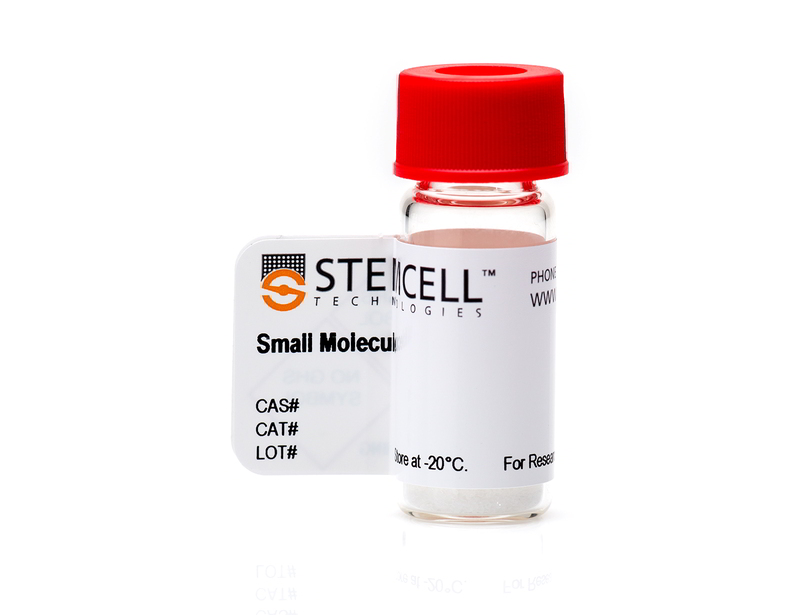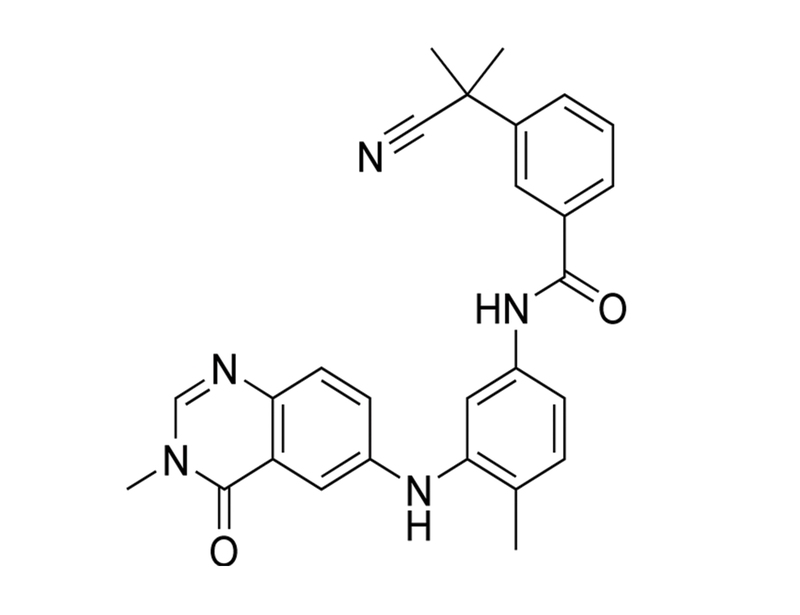概要
AZ628 is a quinazolinone that inhibits several Rapidly accelerated fibrosarcoma (RAF) kinases, including B-RAF, B-RAF V600E, and C-RAF-1 (in vitro kinase assay IC₅₀ values of 105, 34, and 29 nM respectively; Khazak et al.). It strongly promotes B-Raf dimerization as a tight-binding inhibitor with a very slow off rate (Hatzivassiliou et al.; Lavoie et al.). From specificity profiling it is known to prevent activation of several other tyrosine kinases, including kinase insert domain receptor (KDR), discoidin domain receptor 2 (DDR2), Lck/Yes Novel (LYN), feline McDonough sarcoma (FMS), and FMS-like tyrosine kinase 1 (FLT1) (Khazak et al.).
CANCER RESEARCH
· Inhibits tumor growth, induces cell cycle arrest and causes apoptosis in a variety of cancer cell lines, especially in lines with the B-RAF V600E mutation (McDermott et al.; Khazak et al.).
CANCER RESEARCH
· Inhibits tumor growth, induces cell cycle arrest and causes apoptosis in a variety of cancer cell lines, especially in lines with the B-RAF V600E mutation (McDermott et al.; Khazak et al.).
技术资料
| Document Type | 产品名称 | Catalog # | Lot # | 语言 |
|---|---|---|---|---|
| Product Information Sheet | AZ628 | 72982, 72984 | All | English |
| Safety Data Sheet | AZ628 | 72982, 72984 | All | English |
数据及文献
Publications (4)
Nature chemical biology 2013 JUL
Inhibitors that stabilize a closed RAF kinase domain conformation induce dimerization.
Abstract
Abstract
RAF kinases have a prominent role in cancer. Their mode of activation is complex but critically requires dimerization of their kinase domains. Unexpectedly, several ATP-competitive RAF inhibitors were recently found to promote dimerization and transactivation of RAF kinases in a RAS-dependent manner and, as a result, undesirably stimulate RAS/ERK pathway-mediated cell growth. The mechanism by which these inhibitors induce RAF kinase domain dimerization remains unclear. Here we describe bioluminescence resonance energy transfer-based biosensors for the extended RAF family that enable the detection of RAF dimerization in living cells. Notably, we demonstrate the utility of these tools for profiling kinase inhibitors that selectively modulate RAF dimerization and for probing structural determinants of RAF dimerization in vivo. Our findings, which seem generalizable to other kinase families allosterically regulated by kinase domain dimerization, suggest a model whereby ATP-competitive inhibitors mediate RAF dimerization by stabilizing a rigid closed conformation of the kinase domain.
Nature 2010
RAF inhibitors prime wild-type RAF to activate the MAPK pathway and enhance growth.
Abstract
Abstract
Activating mutations in KRAS and BRAF are found in more than 30% of all human tumours and 40% of melanoma, respectively, thus targeting this pathway could have broad therapeutic effects. Small molecule ATP-competitive RAF kinase inhibitors have potent antitumour effects on mutant BRAF(V600E) tumours but, in contrast to mitogen-activated protein kinase kinase (MEK) inhibitors, are not potent against RAS mutant tumour models, despite RAF functioning as a key effector downstream of RAS and upstream of MEK. Here we show that ATP-competitive RAF inhibitors have two opposing mechanisms of action depending on the cellular context. In BRAF(V600E) tumours, RAF inhibitors effectively block the mitogen-activated protein kinase (MAPK) signalling pathway and decrease tumour growth. Notably, in KRAS mutant and RAS/RAF wild-type tumours, RAF inhibitors activate the RAF-MEK-ERK pathway in a RAS-dependent manner, thus enhancing tumour growth in some xenograft models. Inhibitor binding activates wild-type RAF isoforms by inducing dimerization, membrane localization and interaction with RAS-GTP. These events occur independently of kinase inhibition and are, instead, linked to direct conformational effects of inhibitors on the RAF kinase domain. On the basis of these findings, we demonstrate that ATP-competitive kinase inhibitors can have opposing functions as inhibitors or activators of signalling pathways, depending on the cellular context. Furthermore, this work provides new insights into the therapeutic use of ATP-competitive RAF inhibitors.
Expert opinion on therapeutic targets 2007
Selective Raf inhibition in cancer therapy.
Abstract
Abstract
Over the past 5 years, the Raf kinase family has emerged as a promising target for protein-directed cancer therapy development. The goal of this review is to first provide a concise summary of the data validating Raf proteins as high-interest therapeutic targets. The authors then outline the mode of action of Raf kinases, emphasizing how Raf activities and protein interactions suggest specific approaches to inhibiting Raf. The authors then summarize the set of drugs, antisense reagents and antibodies available or in development for therapeutically targeting Raf or Raf-related proteins, as well as existing strategies combining these and other therapeutic agents. Finally, the authors discuss recent results from systems biology analyses that have the potential to increasingly guide the intelligent selection of combination therapies involving Raf-targeting agents and other therapeutics.
Proceedings of the National Academy of Sciences of the United States of America 2007
Identification of genotype-correlated sensitivity to selective kinase inhibitors by using high-throughput tumor cell line profiling.
Abstract
Abstract
Kinase inhibitors constitute an important new class of cancer drugs, whose selective efficacy is largely determined by underlying tumor cell genetics. We established a high-throughput platform to profile 500 cell lines derived from diverse epithelial cancers for sensitivity to 14 kinase inhibitors. Most inhibitors were ineffective against unselected cell lines but exhibited dramatic cell killing of small nonoverlapping subsets. Cells with exquisite sensitivity to EGFR, HER2, MET, or BRAF kinase inhibitors were marked by activating mutations or amplification of the drug target. Although most cell lines recapitulated known tumor-associated genotypes, the screen revealed low-frequency drug-sensitizing genotypes in tumor types not previously associated with drug susceptibility. Furthermore, comparing drugs thought to target the same kinase revealed striking differences, predictive of clinical efficacy. Genetically defined cancer subsets, irrespective of tissue type, predict response to kinase inhibitors, and provide an important preclinical model to guide early clinical applications of novel targeted inhibitors.

 网站首页
网站首页





